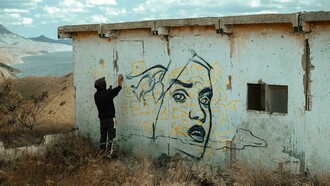The horrors reflected in the fairy tale of Hansel and Gretel derive from the horrors of European history during the Middle Ages. During times of famine children who were a burden on desperate families were abandoned in forests by parents who did not have the heart to kill them outright. Cannibalism was not unusual. In the fairy tale, some historical realities would have been so horrific to relate that they are sweetened just a bit. So it is an evil stepmother (not a real mom) that goads the father to abandon the kids and the consumption of human flesh is only committed by a witch. This mollifying of the excessively distasteful winds up allowing greater symbolism and allegorical interpretations to be imputed to the story, and this seems to be the starting point for Chinese artist Lu Pingyuan in the show Trapping Cooking, Cooking Trapping. It’s a Lovely Life at OCAT in OCT Loft in the Chinese megacity of Shenzhen.
The fictional story of these children has resonated through the centuries partly due to its compellingly gruesome nature but happy ending. The abundance of symbolism and the possible allegories coming from the story has also made it rich reading and teaching material. Indeed, Lu may be revisiting the story as both a spiritual and historical allegory, attempting to reveal the sweetening process involved in constructing narratives that provides all of us with hope in the face of horror. In our attempt to digest the true horrors of reality, but make them more palatable at the same time, we inadvertently create believably optimistic fiction that gives us something to live for.
By creating a flesh-devouring witch instead of raving, starving cannibalistic desperados, you get a spiritual allegory or story of a heroic journey: the classic leaving home, killing something evil, and returning home richer tale. This represents the journey inside, to find the destructive within you, extirpate it and come back to being the peace you want to see in the world. The children are forced against their will to abandon their homes and families. They wander in the wilderness until meeting a do-or-die challenge involving irresistible temptation and a monster that violates all ethical norms. The monster is killed due to its own hubris and blunder and the children return home with riches and save their father. The unseen hand of providence has been working and guiding and it all happened for a reason.
China, too, went through the horrors of famine in recent memory and this makes one wonder whether the artist may also be looking at Hansel and Gretel as an allegory referring to China’s recent history and direction. Of course, we would replace God with historical materialism (history is always moving us toward a social utopia), and the unseen hand of economics takes Hansel and Gretel from abject poverty, through open-door policy (the Wicked Witch of the West invites them in), to socialism with Chinese characters. Hansel and Gretel come home to China with the world’s second-largest economy, poised to become numero uno and relatively independent.
But when we look at the objects in the show we see that Lu is not merely rearticulating a story. We see Hansel and Gretel as melting chocolate figures on a cake. The witch exists merely as a cutout with which to make giant cookies. The storybook itself exists as a shelter within which children can read versions of the story. The story is now a saccharine-charged collection of images and symbols and the invitation for the mass production of even more symbols. Covering the walls, in fact, are a highly creative collection of gingerbread scenarios derived from aspects of the overarching story. It is we who have arrived through our own personal forests. The original story now becomes our destination. We have been traveling toward this story, apparently, our whole lives and we are now here.
The show is about the sweetening process we have bought into and how hope can be created to generate the spiritual. The show seemingly asks us whether we have, in fact, been looking for the fulfillment of this story as we moved through life and to now really examine it based on our experiences in the world forest. Hansel and Gretel were never real children – the Brothers Grimm even made up their names. They have served as spiritual functions for us, the way all of our hope-filled stories have. We have now visited the sugar-filled house of temptation as well, and there might be a monster inside it that we do not notice. Or, there might not be.
The show reminded me a bit of the novel The Life of Pi. One character tells another that he can relate a story that will make the others believe in God. In the end, you realize that the story was fiction, but it possesses undeniable truth, nonetheless. Maybe our journey to this exhibit was meant to reassure us – yes, there is such a thing as spiritual development or, yes, historical materialism is real, history is taking us to a better place. The Hansel and Gretel in the show, indeed, look a bit like confident suburban American white kids (perhaps Boy and Girl Scouts) from the 1960s and confident Red Guards of the same time frame. A fictitious story of hope was derived from a horrific story because true horrors are hard to bear. History easily becomes allegory due to the horror it possesses. Details can be sweetened. This sweetening helps us believe in God or utopia or the inevitable progress of history. So it is the sweetening of the horrors of history that produces honeyed allegories. The children are saved. The witch is killed. Riches are the reward.















